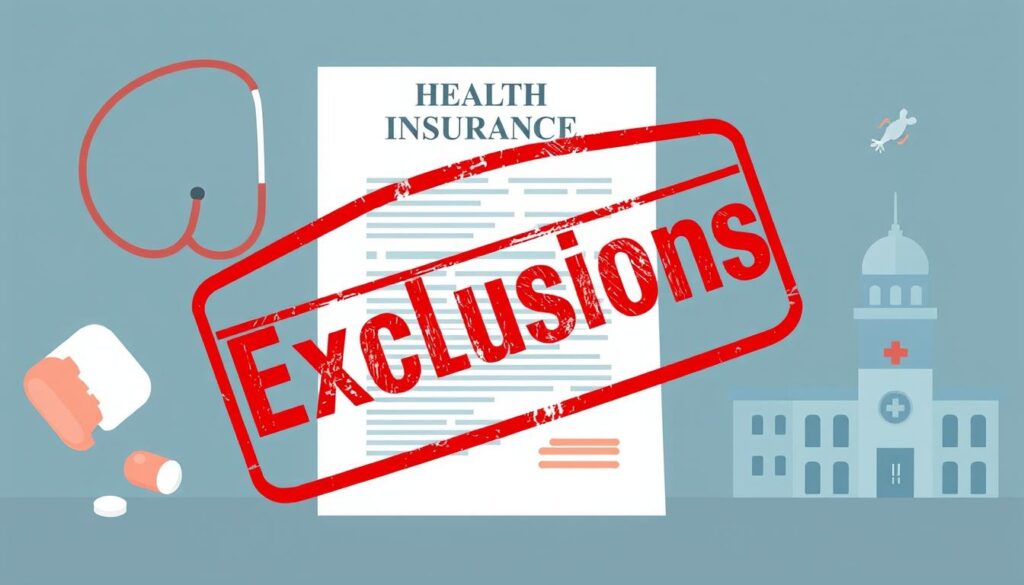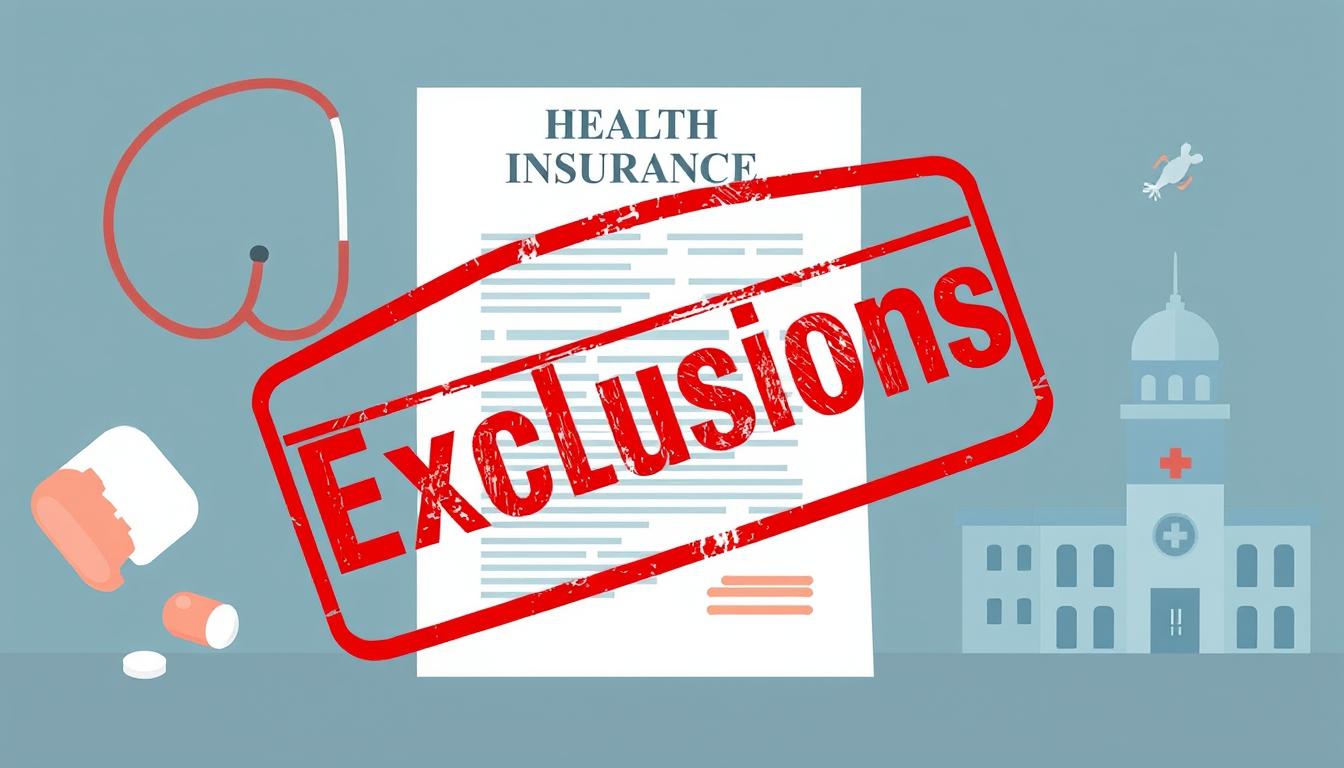Finding the right health insurance can seem overwhelming. But, it’s key for your health and money. We’ll look at the top five things to check when picking a health insurance plan. This will help you find one that fits your needs and budget.

Key Takeaways
- Understand the different types of health insurance coverage and key terms to make an informed decision
- Evaluate monthly premium costs and plan your healthcare budget accordingly
- Prioritize your preferred network of doctors and hospitals to ensure access to quality care
- Carefully review deductibles, copays, and out-of-pocket maximums to manage your healthcare expenses
- Explore additional benefits like prescription drug coverage, telehealth services, and wellness programs
Understanding Health Insurance Basics
Health insurance can seem complex, but knowing the basics is key. There are many types of health insurance plans. Each has its own benefits and features.
Types of Health Insurance Coverage
Common health insurance types include HMOs, PPOs, and HDHPs. HMOs often have lower monthly costs but limit your choice of doctors. PPOs give you more freedom to choose doctors but may cost more.
Key Insurance Terminology
Understanding terms like premium, deductible, copay, and out-of-pocket maximum is crucial. These terms affect how much you pay for healthcare. Knowing them helps you manage your healthcare costs better.
How Health Insurance Works
Health insurance splits the cost of medical care between you and your provider. Your plan covers part of the costs, and you pay the rest. It’s important to know how your plan works to manage your healthcare budget.
Learning about health insurance types, key terms, and how it works helps you. You’ll be able to find a plan that fits your needs and budget.
“Health insurance is not just a luxury, it’s a necessity in today’s world. Protecting your financial well-being and access to quality healthcare should be a top priority.”
Monthly Premium Costs and Budget Planning
When picking a health insurance plan, the monthly cost is key. Premiums change based on coverage, deductibles, and who’s in the network. Finding a balance between cost and coverage is vital for your budget.
To pick the right plan, first look at your health needs and costs. Think about your usual medical bills, any ongoing health issues, and how often you see doctors or need procedures. This helps you choose the right coverage without paying too much for things you don’t need.
- Check your budget and decide how much you can spend on health insurance each month.
- Compare prices from different providers to find the best deal that fits your needs.
- Explore ways to lower your premiums, like employer help, government aid, or combining plans.
“Balancing health insurance premiums with your overall budget is key to ensuring you have the coverage you need without breaking the bank.”
The aim is to get a plan that’s affordable and protects your health. By looking at your premium costs and matching them to your budget, you can choose wisely. This choice supports your financial health in the long run.
Network Coverage and Provider Options
Choosing a health insurance plan means looking at network coverage and provider options. The healthcare network includes doctors, hospitals, and facilities that work with your insurance. This is key because it affects how much you pay out of pocket.
In-Network vs. Out-of-Network Providers
In-network providers agree to accept your insurance’s rates. Going to them means lower costs for you. Out-of-network providers don’t have this deal, so you might pay a lot more.
Finding Your Preferred Doctors
It’s vital to pick a plan that includes your favorite doctors. Check the insurer’s website or call customer service to see if your doctors are in-network.
Hospital Network Coverage
Don’t forget about hospital network coverage. Make sure your preferred hospitals are included. Out-of-network hospital costs can be very high and surprise you.
Knowing about healthcare networks, in-network and out-of-network providers, and hospital coverage helps you choose wisely. It keeps you from facing unexpected medical bills.
Deductibles and Out-of-Pocket Maximums
When picking a health insurance plan, knowing about deductibles and out-of-pocket maximums is key. These elements greatly affect your healthcare costs and financial health.
A deductible is what you pay first before your insurance starts. Higher deductibles mean lower monthly premiums. But, you’ll pay more for initial medical costs. Lower deductibles lead to higher premiums but less out-of-pocket expenses when you use your insurance.
The out-of-pocket maximum is the most you’ll pay for covered services in a year. After hitting this limit, your insurance covers 100% of your healthcare costs for the rest of the year. Picking a plan with a lower out-of-pocket maximum can offer financial security, especially if you expect high medical bills.
- Think about your health and expected medical needs when choosing a deductible.
- Find a plan with an out-of-pocket maximum that fits your budget and financial situation.
- Remember, the lower the deductible, the higher the monthly premiums, and vice versa.
“Finding the right balance between deductibles and out-of-pocket maximums is key for managing your healthcare cost-sharing and keeping finances stable.”
Understanding health insurance deductibles and out-of-pocket costs helps you make a smart choice. You can pick a plan that meets your needs and budget.
Prescription Drug Coverage Benefits
Prescription drug coverage is key in a good health insurance plan. It lets you get the medicines you need without spending too much. Knowing how prescription drug benefits work helps you choose the best health plan for you.
Generic vs Brand Name Medications
Prescription drugs come in two types: generic and brand-name. Generic medications are just as good as brand-name ones but cost less. Most health plans cover generic drugs more because they save money for everyone.
Pharmacy Network Options
Another big part of drug coverage is the pharmacy network. Health plans work with certain pharmacies to offer lower prices. Knowing your plan’s network helps you save money on prescriptions.
Prescription Tiers Explained
- Tier 1: Generic medications with the lowest out-of-pocket costs
- Tier 2: Preferred brand-name medications with slightly higher costs
- Tier 3: Non-preferred brand-name medications with the highest out-of-pocket costs
- Tier 4: Specialty medications, often used to treat complex conditions, with the highest costs
Understanding the prescription drug tiers helps you spend less while getting the medicines you need.
“Prescription drug coverage is a critical component of a comprehensive health insurance plan, providing access to essential medications and potential cost savings.”
Preventive Care and Wellness Programs
Keeping good health is key, and preventive care is vital. Health insurance plans offer preventive healthcare and wellness benefits. These help you stay healthy by offering regular check-ups and health screenings.
Regular visits to your doctor can catch health problems early. Health screenings like annual physicals and cancer tests help too. They can find issues before they cost a lot to fix.
Many plans also have wellness benefits to support a healthy life. You might get fitness programs, nutrition advice, or discounts on gym memberships. These can help you stay well and prevent chronic diseases.
“An ounce of prevention is worth a pound of cure.” – Benjamin Franklin
Preventive care and wellness programs are good for you and the healthcare system. They help find health issues early and encourage healthy habits. This can save money and resources in the long run.

When picking a health insurance plan, look at the preventive healthcare and wellness benefits. Make sure they fit your health needs and goals. Using these services can help you stay healthy and save money over time.
Additional Benefits and Special Features
When picking a health insurance plan, look beyond basic coverage. Consider the extra benefits and special features that can improve your healthcare experience. Features like telehealth services, mental health coverage, and alternative medicine options can greatly support your wellbeing.
Telehealth Services
Telehealth services are getting more popular. They offer easy and accessible healthcare options. Many plans now cover virtual consultations, letting you get medical advice and treatment at home. This is great for those with busy lives, mobility issues, or living far from healthcare services.
Mental Health Coverage
Taking care of your mental health is as crucial as your physical health. Look for plans with strong mental health benefits. These include therapy, counseling, and help with medication. This ensures you get the support you need for your overall health and wellness.
Alternative Medicine Options
- Some plans also cover alternative medicine like acupuncture, chiropractic care, and massage therapy. These therapies offer holistic approaches to healthcare, complementing traditional medical treatment.
- When choosing a plan, check the range of alternative medicine services included. Also, be aware of any limitations or costs you might face with these benefits.
Understanding the additional benefits and special features in health insurance plans helps you make a better choice. This choice should meet your unique healthcare needs and preferences.
Understanding Health Insurance Policy Exclusions
When you pick a health insurance plan, knowing about exclusions and limits is key. These can affect how much you pay for medical care. You might face unexpected costs.
Pre-existing conditions are a big issue. Many plans won’t cover you right away if you have a health problem before joining. This is a big worry for people with ongoing health issues.
- Cosmetic procedures: Most plans don’t cover things like liposuction or Botox. This includes surgeries or treatments for looks.
- Experimental or investigational treatments: New treatments that are still being tested might not be covered. This is because they’re not proven yet.
- Routine vision and dental care: Some plans might offer a bit of vision or dental coverage. But, many don’t cover things like eye exams or teeth cleanings fully.
“Carefully reviewing the exclusions and limitations in your health insurance policy can help you avoid unexpected gaps in coverage and ensure you have the protection you need.”
It’s important to know about exclusions when choosing a health insurance plan. This way, you can pick a plan that fits your needs and budget. Being informed helps you avoid financial surprises later.

Navigating Coverage Limitations
Health insurance plans also have limits on coverage. These can include limits on visits or treatments. Or, they might restrict who you can see for care. It’s good to check these limits to know what you might have to pay for.
- Limits on mental health or substance abuse treatment
- Caps on physical therapy or chiropractic care sessions
- Restrictions on out-of-network provider usage
Understanding your health insurance policy well helps you make smart choices. This way, you can protect your health and finances better.
Comparing Different Insurance Providers
Choosing a health insurance plan means comparing different providers. Look at insurance company ratings, read customer reviews, and check the reputation and financial stability. This helps you pick the best plan for your health needs.
Start by researching insurance provider ratings from trusted sources. Check out ratings from J.D. Power, A.M. Best, and the National Committee for Quality Assurance (NCQA). These ratings show how satisfied customers are and how well the insurer handles claims.
Also, read customer reviews to hear from others. Look on Yelp, Google, and the Better Business Bureau. These sites share experiences with customer service, coverage, and claims handling.
Lastly, look at the reputation and financial stability of the provider. Choose insurers known for reliability and financial strength. This ensures they can handle claims well and keep their promises.
Comparing health insurance providers helps you find a plan that’s affordable and covers your needs. This way, you can stay healthy and well.
Conclusion
Choosing a health insurance plan is a big decision. It’s important to think about many factors to make the right choice. This includes the monthly costs, network coverage, and provider options.
Looking at deductibles, out-of-pocket maximums, and prescription drug benefits helps you plan for healthcare costs. Also, consider preventive care, wellness programs, and telehealth services. These can add value to your health insurance plan.
Deciding on a health insurance plan is a personal choice. It’s key to research well, understand what’s not covered, and compare different providers. This way, you can find a plan that meets your health and financial needs.
FAQ
What are the most important factors to consider when choosing a health insurance plan?
Important factors include coverage options and monthly costs. Also, consider network providers, deductibles, and out-of-pocket maximums. Don’t forget about extra benefits like prescription drugs and preventive care.
How do I understand the different types of health insurance coverage?
There are HMOs, PPOs, and HDHPs. Each has its own features, network rules, and cost-sharing. Knowing these can help you choose the right plan for you.
What are the key insurance terms I should know when selecting a plan?
Key terms are premium, deductible, copay, coinsurance, and out-of-pocket maximum. These terms affect your healthcare costs. Understanding them helps you manage your expenses.
How do I estimate my monthly health insurance premium costs?
Premium costs depend on your age, location, coverage level, and health conditions. It’s crucial to find a balance between cost and coverage to get a plan that fits your budget.
What is the difference between in-network and out-of-network providers?
In-network providers offer lower costs. Out-of-network providers charge more. Always check the network coverage to save money.
How do deductibles and out-of-pocket maximums affect my healthcare costs?
Your deductible is what you pay before insurance kicks in. The out-of-pocket maximum is the yearly cap on costs. Choosing the right deductible helps manage your healthcare expenses.
What should I consider when evaluating prescription drug coverage?
Look at coverage for generics and brands, pharmacy networks, and medication tiers. These factors impact your costs for different medications.
How important are preventive care and wellness benefits in a health insurance plan?
Preventive care and wellness programs are vital. They help keep you healthy and can lower long-term costs. Look for plans that offer these services at little to no cost.
What additional benefits and special features should I consider in a health insurance plan?
Consider telehealth, mental health coverage, and alternative medicine. These features ensure your plan covers all your healthcare needs.
How do I identify and understand health insurance policy exclusions?
Review policy details to find exclusions or limitations. This helps avoid unexpected gaps in coverage, especially for pre-existing conditions.
How can I effectively compare different health insurance providers?
Research company ratings, read reviews, and check reputation and financial stability. This helps you choose the best provider for your needs.
